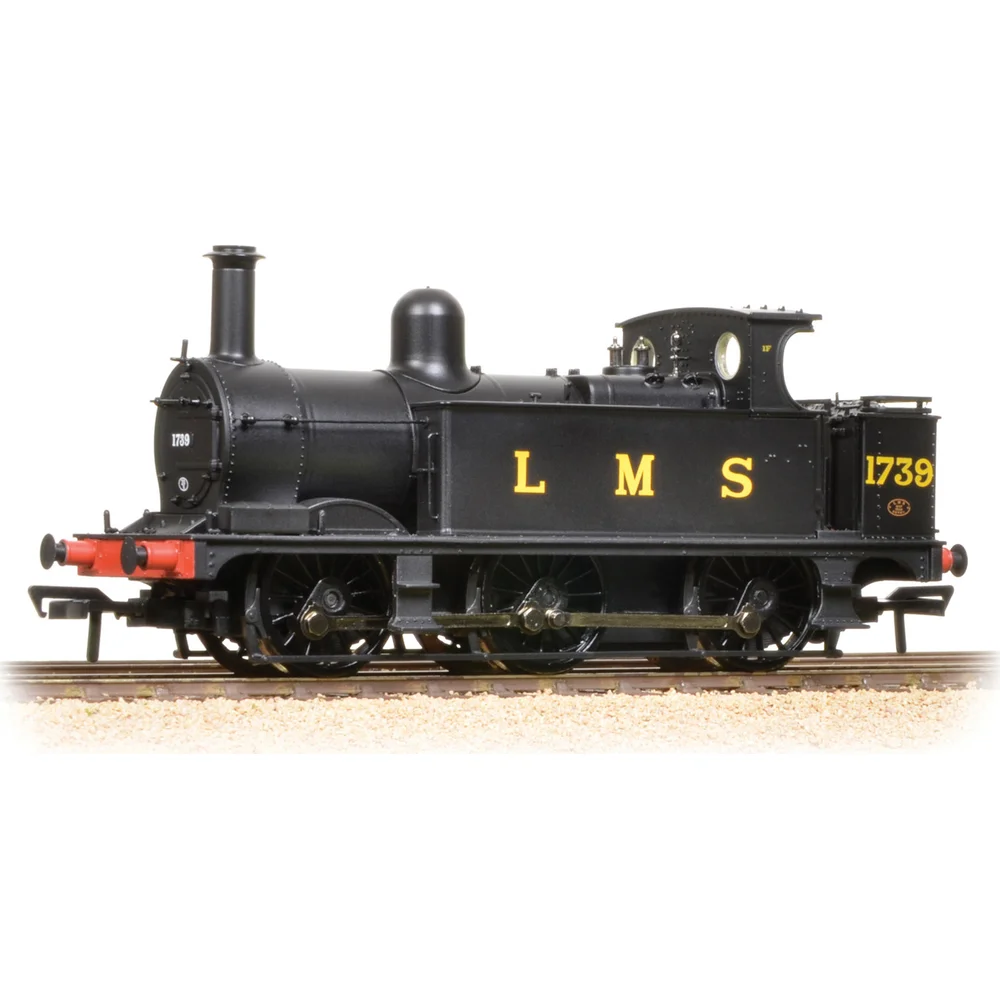Bachmann 31-433
Midland Railway 1377 Class 1739 London, Midland & Scottish Railway Black
Tooling
Introduction & Context
In 2014, Bachmann Branchline introduced a completely new tooling for the Midland Railway Class 1F 0-6-0T, also known as the Johnson 1377 Class or “Half-Cab” tank engine. Originally built between 1878 and 1892 for the Midland Railway, these locomotives later served under LMS and BR ownership. The model was designed to capture the distinctive open cab and compact proportions of this classic shunting locomotive.
Tooling Features
- Scale: OO gauge (1:76.2)
- Construction: Combination of die-cast metal chassis and injection-moulded plastic body for strength and fine detailing.
- Detailing: Factory-fitted handrails, turned brass safety valves and whistle, detailed cab interior with glazing, and optional bufferbeam detail pack. Open cab versions include a folded tarpaulin representation.
- Couplings: NEM pockets with tension-lock couplers.
Mechanical & Electrical
- Motor & Drive: Smooth-running can motor mounted in the body, driving all three axles via a robust gear train.
- Minimum Radius: Second radius curves (approx. 18 inches / 450 mm).
- Weighting: Metal chassis provides good adhesion for shunting duties.
- Lighting: No factory lighting provision.
DCC Capability
The model is DCC Ready with a 6-pin NEM651 socket located in the bunker. All-wheel electrical pickup ensures reliable performance. Sound installation requires modification as no speaker provision is included.
Liveries Produced
The tooling has been released in multiple authentic liveries, including Midland Railway, LMS black, and BR black with early and late crests. Both open and closed cab variants have been offered.
Reviews & Commentary
The 2014 Bachmann 1F received positive reviews for its accurate proportions, fine detailing, and smooth running qualities. Model Rail and BRM praised the cab detail and the realistic finish on rods and wheels. Social media discussions highlighted its appeal for shunting layouts and its suitability for branch line scenes.
Interesting Notes
Aftermarket upgrades such as the Brassmasters EasiChas kit allow conversion to EM or P4 gauge, adding sprung suspension and correcting overscale splashers for finescale modellers.
Class & Prototype
- Class: Midland Railway 1377 Class
- Traction: Steam
- Built: 1878-1892
- Total Built: 185
- Running Number: 1739
The Midland Railway 1377 Class were Samuel W. Johnson's distinctive "half-cab" 0-6-0 tank engines, with 185 built 1878-1892 for shunting and light freight duties. These Victorian workhorses served for 87 years across the MR, LMS, and BR eras, with five surviving until September 1965 under a remarkable 100-year Staveley Ironworks contract. One locomotive (No. 41708) is preserved at Barrow Hill and inspired Bachmann's detailed OO gauge model range (31-430 through 31-435, now discontinued but available secondhand).
Operator & Livery
- Operator: London, Midland & Scottish Railway
- Livery: Black
- Era: 3 - The big 4 – LMS, GWR, LNER & SR
The London, Midland & Scottish Railway (LMS) was Britain's largest railway company from 1923-1948, formed by merging over 120 independent railways under the Railways Act 1921. Operating 7,790 route miles across England, Scotland, Wales, and Northern Ireland, the LMS became the world's largest transport organisation and the British Empire's biggest commercial enterprise. Famous for iconic locomotives like the streamlined Princess Coronation class, versatile Black Fives, and Royal Scots, the company evolved from inherited pre-grouping designs to revolutionary Stanier innovations. The LMS operated major routes including the West Coast Main Line from London Euston to Scotland, serving as the UK's second-largest employer after the Post Office. Nationalised in 1948 to form British Railways' London Midland Region, the LMS legacy continues through extensive preservation efforts and remains a favourite subject for railway modellers seeking authentic British steam-age prototypes.
The LMS plain black livery served as the standard finish for freight locomotives and represented practical railway economics during the company's existence. Applied without lining or embellishment, this utilitarian scheme recognised that goods engines operated in inherently dirty conditions where elaborate paintwork proved both expensive and impractical.
Most LMS freight classes including the ubiquitous 0-6-0 goods engines, 0-8-0 heavy freight locomotives, and tank engines used for shunting duties wore plain black throughout their service lives. The scheme extended beyond locomotives to goods wagons, where black paint provided adequate weather protection at minimal cost.
During World War II, plain black became increasingly common as material shortages and wartime economies forced the abandonment of more elaborate liveries. Even some passenger locomotives temporarily adopted unlined black finishes when crimson lake supplies became unavailable. The practical benefits of black paint - its ability to hide dirt, soot, and industrial grime - made it ideal for locomotives working coal trains, mineral traffic, and heavy industrial duties.
For modellers, plain black represents the workhorse reality of LMS operations, particularly appropriate for freight yards, colliery branches, and industrial settings where authentic weathering and operational realism take precedence over passenger train glamour.
